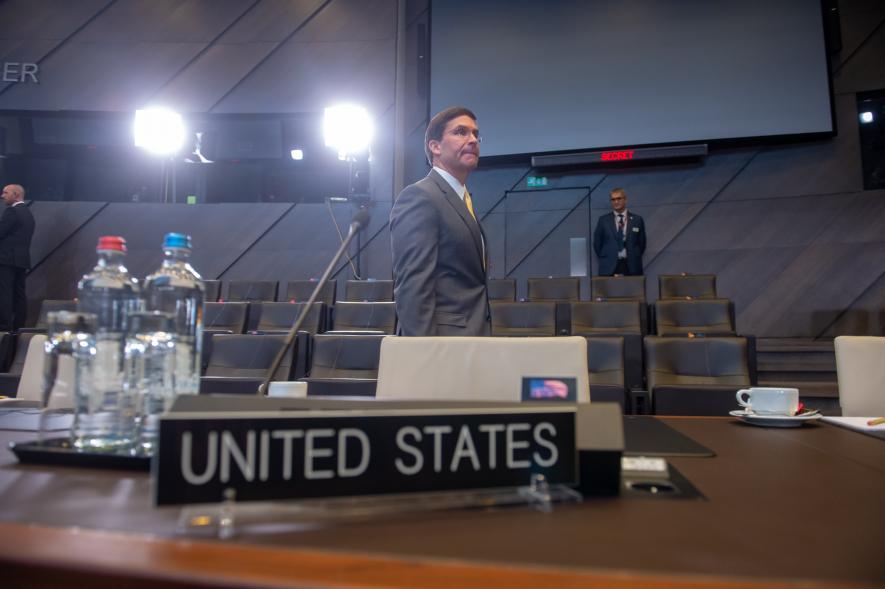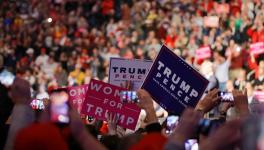Emerging Contours of the US-Indian Military Alliance

Esper Walk: Mark T. Esper (US Secretary of Defense) looks around the North Atlantic Council room at NATO headquarters in Brussels. (File photo)
The mystery about the awkward timing of the so-called 2+2 US-Indian security dialogue due in New Delhi on October 27 is largely because there is a chicken-and-egg situation about it.
It is impossible to decide which of two things caused the other one — the mushrooming US-Indian military alliance or the continuing downhill slide in the India-China relationship.
There is a curious dialectic at work today — on the one hand, the US-Indian military alliance was struggling to take off notwithstanding the 2008 nuclear deal, but it began accelerating (after the BJP came to power) in 2015, while on the other hand, the Sino-Indian relationship had acquired a degree of predictability during the UPA rule, but it steadily, inexplicably began degrading under Prime Minister Narendra Modi’s watch and has been reduced to a state of acute rivalry bordering on motiveless malignity.
The paradox lies here — Indians at large have a tunnel vision of the mushrooming alliance with the US (QUAD being its most visible template) while the Americans have a much broader global vision of what they are methodically building with India.
Also read: Ballots Defeat Bullets: Socialist Party Wins Historic Mandate in Post-Coup Bolivia
Within this paradox, there is also an enigma: The Indians at large harbour a notion that their country is cherrypicking out of the American basket of goodies but the policymakers in Delhi and the political leadership are well aware that it can only be a pipe dream since a military alliance with a superpower is a profound irrevocable commitment.
The American analysts lavishly compliment our External Affairs Minister S. Jaishankar as the mechanic who is assembling the QUAD, keeping his head below the parapet. Some Indian analysts have tended to see the 2+2 on Monday just a week before the November 3 in the US election as a rushed event. But they fail to comprehend the great deliberateness about the timing of the 2+2 meet.
It must be held now, precisely now, before November 3, for the reason that even a week later, a host of uncertainties can arise if a Joe Biden presidency sails into view. As the saying goes, there could be many a slip between the cup and the lip. And all those nuts and bolts Jaishankar has been screwing into the prototype in his closed garage — BECA being the finishing touch — may start rusting if a cranking of the engine doesn’t happen now.
After such a long effort, hidden from public view, the engine has been assembled, but in order to get the engine running, it first needs to be rotated at sufficient speed so that the fuel gets pumped up to the cylinders and ignited, and enables the engine to run on its own power. Any car mechanic would know that cranking the engine — that is, turning the engine’s crankshaft — is necessary at this point to make sure he can rotate the engine to power itself.
A defining moment has come for the US-Indian military alliance. The test driver is flying in from the US. Secretary of State Mike Pompeo is bringing Defence Secretary Mark Esper for the prestigious assignment to test the efficacy of the US-Indian military alliance. It cannot and should not be delayed.
The Indian side has a problem with Esper, a thorough professional with a remarkable record — an infantry officer with the 101st Airborne (“Screaming Eagles”) who saw active service during Desert Storm and the Gulf War (awarded the Bronze Star); graduated in engineering from West Point; holds masters from Kennedy School at Harvard and PhD from George Washington; deputy assistant secretary of defence; and, Secretary of the Army before taking over as Pentagon chief.
Esper neither has a counterpart in our MOD nor any counterpart in Modi’s cabinet who matches up to him in erudition and professional skill. That is what makes the transcript of his “conversation” with the CEO and President of the Atlantic Council Frederick Kempe on October 20 — in anticipation of his trip to India — a must read.
Esper thoughtfully picked as topic for his discussion, Strengthening US alliances and partnerships in an era of great-power competition — just what his trip to India is all about.
Esper gave us a fantastic preview of the road map he will be carrying to Delhi to test drive the engine that Jaishankar assembled. The following elements that Esper highlighted are worth summarising, largely in his own words:
Pentagon’s “number one priority” is implementing the US National Defence Strategy, which enumerates that the US is presently “in an area of great-power competition, with our primary competitors being China and Russia.”
In this context, Pentagon pursues three “lines of effort: first, improving the lethality and readiness of the (US) force; second, strengthening alliances and building partnerships; and third, reforming the (Defence) Department to redirect our time, money, and manpower to our highest priorities.”
A network of allies and partners is crucial as it “provides us (America) an asymmetric advantage our adversaries cannot match… China and Russia have probably fewer than ten allies combined.”
However, the US cannot rest its oars as “our primary competitors – China and Russia – are rapidly modernising their armed forces… and shift the balance of power in their favour…and undermine the resilience and cohesion of countries and institutions critical to US security, including NATO.”
This will “require us to think and act more strategically and competitively.” The Pentagon has “two recent initiatives that will help us to do just that” — a new Department of Defense Guidance for Development of Alliances and Partnerships (GDAP) and the so-called Defense Trade Modernisation.
Together, these two instruments will help the US to “build the capacity and capabilities of like-minded nations and foster interoperability with friendly militaries”, while also providing stimulus to the American arms industry so that it “can compete in the global marketplace.”
The GDAP aims to reorientate the US’ engagements with allies and partners from the traditional mode of “regional priorities and interests” towards the new era of great power competition that is global in nature, which requires a “common set of priorities.”
The Pentagon has a “toolkit” for this purpose, which consists of intensively cultivating senior military officials in foreign militaries and the Foreign Military Sales programme.
The Foreign Military Sales is crucial insofar as it helps the US to better utilise its premier equipment, technology, and systems “as a strategic tool” to help the partners’ war-fighting capabilities as well as build interoperability. In the process, of course, it also keeps the US arms industry innovative and competitive in the global marketplace.
Besides, the Foreign Military Sales also counters the Chinese and Russian state-owned arms industries, which are fiercely competing “to expand their share of the world’s weapons market”, “attract other countries into their security networks” and frustrate the USt’ efforts to cultivate relationships.
Esper summed up that the 2+2 Dialogue in Delhi on Monday reflects “our nations’ ever-increasing convergence on the strategic issues of our time.” He drew satisfaction that the trajectory of military exercises, defence cyber dialogue and so on through recent months “will strengthen what may become one of the most consequential partnerships of the 21st century.”
Interestingly, Esper disclosed that last week there was a meeting of the so-called Five Eyes forum — intelligence grouping of US, UK, Canada, Australia and New Zealand — where “we talked about the challenges in the Indo-Pacific, and how do we—how do we cooperate together? How do we confront these challenges to sovereignty, to the international rules-based order, to freedom of navigation? So you see a lot more closer collaboration come out. And this’ll be reflected in our meetings next week in New Delhi, as well, when we travel there.”
(A second part will follow.)
Also read: Haiti Has a Long History of Being Assaulted by Its Latin American Neighbors
Get the latest reports & analysis with people's perspective on Protests, movements & deep analytical videos, discussions of the current affairs in your Telegram app. Subscribe to NewsClick's Telegram channel & get Real-Time updates on stories, as they get published on our website.























